Click the titles of each activity and it will take you to the original Facebook post with more photos and videos.
All of the activities below are specifically for children who are working with Phase 5 and 6 of ‘Letters and Sounds’. That’s not to say that other activities from the other categories can’t be adapted but these activities either focus on learning the alternative grapheme for the same phoneme (Phase 5), alternative phonemes for the same grapheme (Phase 5) or games where children can practice applying the spellings rules for adding suffixes (Phase 6).
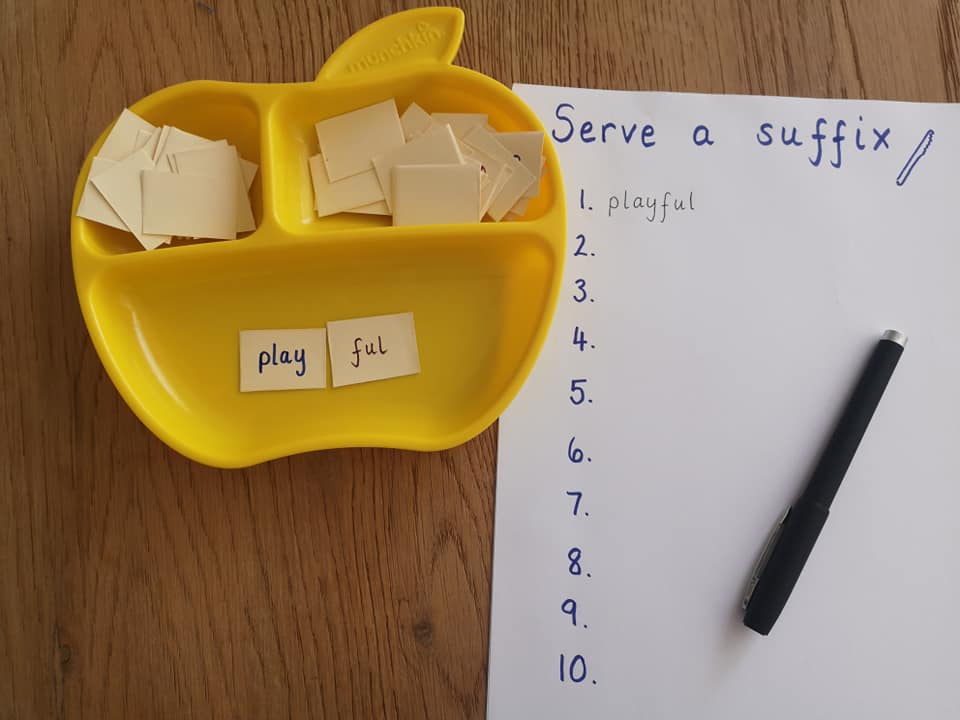
Serve a Suffix
Children will need to be aware of the spelling rules for adding a suffix. Here is a video from the BBC which explains some of the rules, for example if a word ends in a consonant and then a ‘y’ you change ‘y’ to an, ‘i’ before adding the suffix.
https://www.bbc.co.uk/…/english-ks2-wonderful-words…/zdnd7nb
I used a children’s plate/tray that has three segments but you could easily just use two bowls. One section has all the root words (verbs) and the other has a selection of suffixes. Your child takes a card from each side and decides whether it makes sense. If it does they then have to decide if they need to change anything in order to spell it correctly. Look through the photos and hopefully that will make it clearer. They write the word with the correct spelling on the piece of paper. The aim is to collect 10 words spelt correctly. They will also need to be careful as some words change totally when they are changed to past tense, ie we don’t say we ‘swimmed’ we say ‘swam’. If they can change these correctly they can add it to their list too.

I made the post boxes using Duplo but you could cut a hole in a couple of cereal boxes or use a box that has a handle hole. Each post box is labelled past or present and has a number. This number is important as it informs your child whether to change the word on the envelope into the past tense by adding the suffix ‘ed’ or present tense by adding the suffix ‘ing’.
Your child picks an envelope from the bag. Reads the word and looks at the stamp. 1p stamp means past tense and 2p stamp means present tense. They then add the suffix to the word. They will need to think about all the spelling rules for adding a suffix, for example taking off the ‘e’ before adding ‘ing’ or doubling the consonant like in the word ‘hop’. Some of the words will require your child to change the word completely, for example changing the word ‘eat’ to ‘ate’.

Another activity for children in Phase 5 who are learning the alternative spellings for the same phoneme and what better motivation than getting to eat some treats!
I created some cards with the Phase 3 graphemes on and then wrote the alternative graphemes for that phoneme across a couple of sheets of paper. I placed the smarties under each of the graphemes and they act like a sound button. Your child picks a card and says the phoneme. They then find all the alternate spellings for that phoneme and get to eat all of the treats underneath.
For children working in Phase 2-4 you could just have smarties under graphemes. You say the sound and they eat the corresponding treat. You could also place out the smarties like sound buttons. They press each of the buttons segment the word, blend the word together and then get to eat the treats.
The treat can be whatever your child enjoys.
Yum!

A useful tool to help demonstrate the concept of a split digraph. Attach the graphemes for a split digraph onto trouser hangers. You can then show that even though the digraph has been split, and a consonant can go in the middle, it is still attached together and making the same phoneme.
Have a selection of other consonant grapheme cards and you say a word and your child selects the correct split digraph hanger and grapheme cards to spell the word. I used the cards from the ‘Playing Card Phonics’ activity I posted a while ago.
You could leave your child to independently build words using the hangers and cards and record all the split digraph words they have made on a piece of paper.

I made this game for children working in Phase 5 who are learning that different graphemes (letters and combinations of letters) can make the same phoneme (sound) but this activity can easily be adapting to suit children working in Phase 2-4 by adapting the words.
I concentrated on the ‘c’ grapheme making a ‘s’ sound in words. In split digraph words if they see a ‘c’ in the middle it most likely will be making a ‘s’ sound like in space, race, spice, dice.
Using a folded black bin bag I wrote on some real and non-words using a silver permanent marker. You could stick on small bits of masking tape with the words or just write on normal paper. Make a trail of real words first running from one side of the bag to the other. Then add the rest of the words which need to be non-words. Cover each word with an asteroid (stone).You can also add other stones with no word underneath to act as a decoy.
The aim is for your child to make a path through the asteroids to get to the other side. They pick up an asteroid and read the word underneath. If it is a non-word or no word underneath they replace the asteroid. If it is a real word they can remove the asteroid.
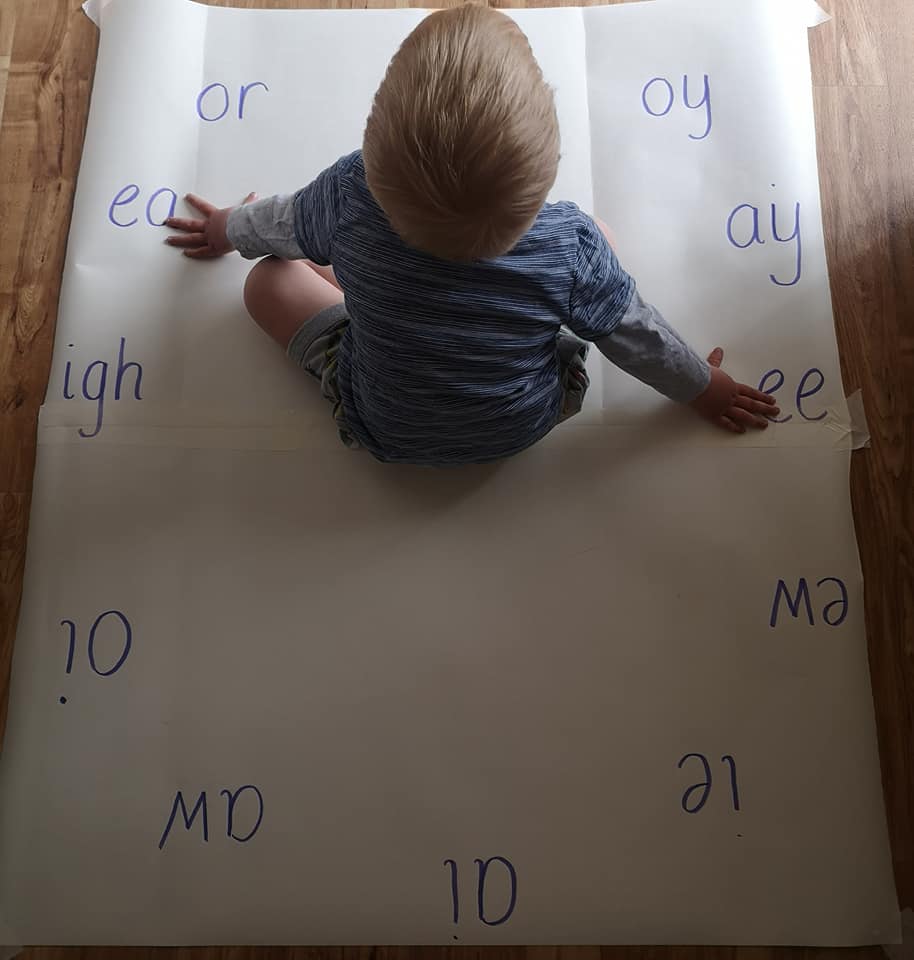
A great game for developing phonic knowledge but also physical skills such as balance, coordination and use of both side of the body and therefore brain!
Using a large piece of paper (you could just as easily use chalk outside) I drew some graphemes as if they were the numbers on the clock. The graphemes at the bottom of the clock are written so the person in the middle can see them the right way up. Your child sits in the middle and there are two ways to play depending on the phase.
1. Children working in Phase 5 you write a Phase 3 grapheme as well as the alternate Phase 5. You say the phoneme (sound) and they use their hands, just like the hands of a clock, to point to the corresponding two graphemes that make that sound, for example ee and ea, ie and igh, ai and ay.
2. Children working in Phase 3 and 4 have a selection of graphemes written and you say a word and your child has to segment that word and point to the correct graphemes that make it, for example ‘chart’ they point to ‘ch’, ‘ar’ and ‘t’. They have to stay facing the top of the clock so will have to twist their bodies around to point to the graphemes and therefore use good balance and control.
Children in Phase 2 you could just have initial letters on the clock and they point to the corresponding letter when you say the sound.
Thanks to my son for demonstrating (albeit reluctantly) as this activity is a little advanced for him.

I set this up whilst my youngest was having a nap so that he couldn’t come and Godzilla all over it! A really quick game to prepare. I’ve posted the pairs game before using post it notes (see the ‘Post It Note Phonics’ activity) but it’s really nice to do it on a larger scale.
You could play the game with initial sounds, matching the same digraphs and trigraphs from Phase 3 and 5 or with tricky words. A great way to support learning the alternatives in Phase 5 too. Your child turns a plate, says the phoneme and has to find the alternative grapheme that makes the same sound.
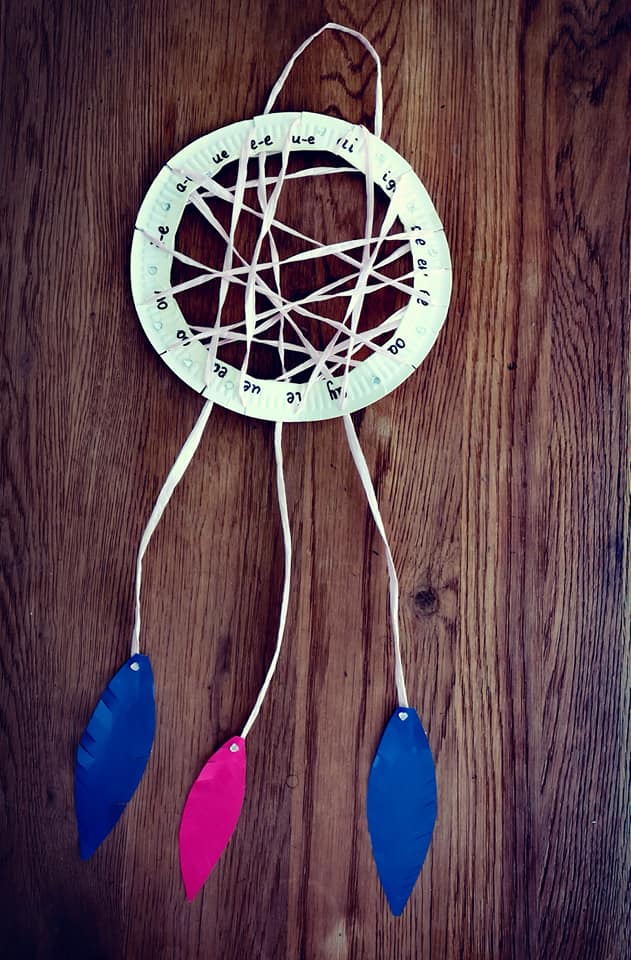
This is the perfect activity for children who are into crafting and learning to recall the Phase 5 alternatives to the Phase 3 phonemes, for example ‘ue’, ‘ew’, and ‘u-e’ as an alternative to ‘oo’
I cut the centre of a paper plate out. I then wrote some Phase 3 graphemes along with their Phase 5 alternatives around the paper plate. I chose some alternatives for ‘ai’, ‘ee’, ‘igh’, ‘oa’ and ‘oo’. You will also need some string or wool. I made a small slit above all the graphemes where the string can be inserted.
Starting at any Phase 3 grapheme tie the string on the back of the plate. Now your child passes the string through the small slit above each of the alternative graphemes for that phoneme. Repeat with all the other phase 3 phonemes.
I used:
ai, ay, a-e
ee, ea, e-e
igh, ie, i-e
oa, ow, o-e
oo, ue, ew, u-e
Once your child has passed the string through every grapheme tie the string around the plate. They can now colour it in, add further decorations and hang on the wall. 😊

Another fun and practical activity that offers lots of scope to adapt to fit the phase your child is working at and also your child’s interests. It doesn’t have to be a Honeybee and honeycomb you could have an aeroplane landing on a island, rocket landing on a planet or butterfly landing on flowers.
I created a honeycomb outline by drawing around some hexagons onto a piece of large paper and inside each hexagon I wrote a word. The words inside my honeycomb would suit children working within Phase 5 as I chose to focus on alternative graphemes for the phoneme ‘ee. I had words that contained:
‘ee’ like in ‘bee’
‘ea’ like in ‘tea’
‘e-e’ like in ‘theme’
‘y’ like in ‘buzzy’
‘ey’ like in ‘honey’
Adapt the words on the large sheet appropriate to the phase your child is working at. It could be Phase 2 letter recognition, letters within your child’s name or tricky words.
I then drew a bee picture and attached a tube of card to the back with one end sealed. Place a straw in the other end. When your child blows into the straw the bee will shoot out. Look in the comments for a short boomerang video of this in action.
Your child blows the straw to make the bee fly and land on the honeycomb. They then read the word closest to where the bee lands.
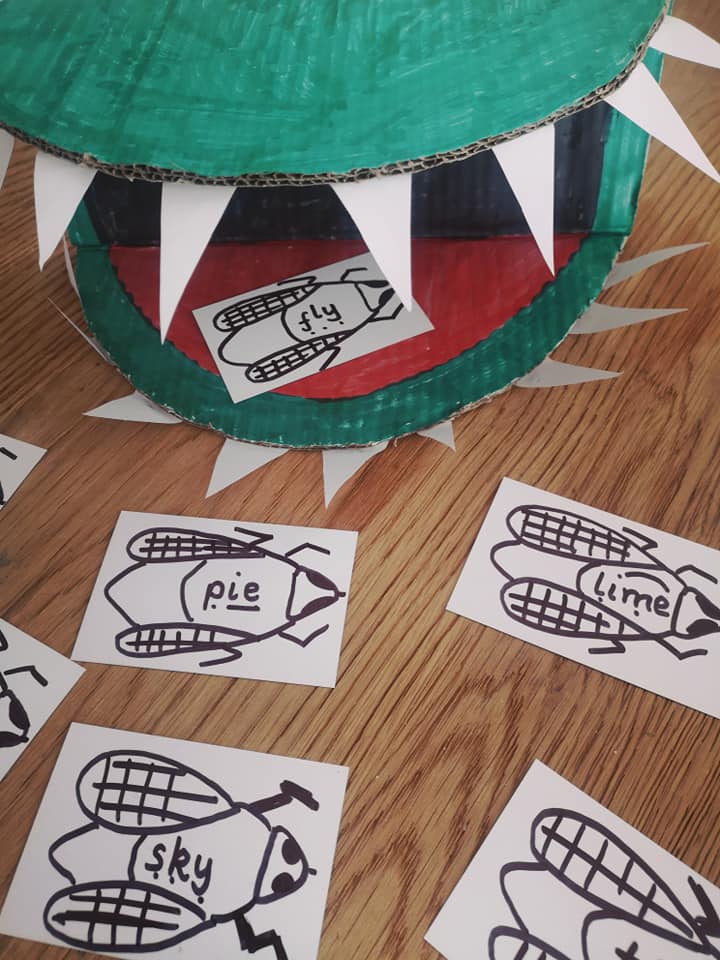
A great game for children learning to identify the alternative graphemes for the Phase 3 ‘igh’. I drew some quick outlines of flies onto small pieces of card and then inside each fly I wrote a word. I had words that used ‘ie’, ‘i-e’ and ‘y’. Your child reads through the words and feeds all the flies to the fly trap that use the ‘y’ grapheme to make an ‘igh’ phoneme, as in ‘fly’. A great opportunity to also use a plastic fly swat with the remaining flies not eaten by the trap. You could say a word and your child swats the corresponding fly.
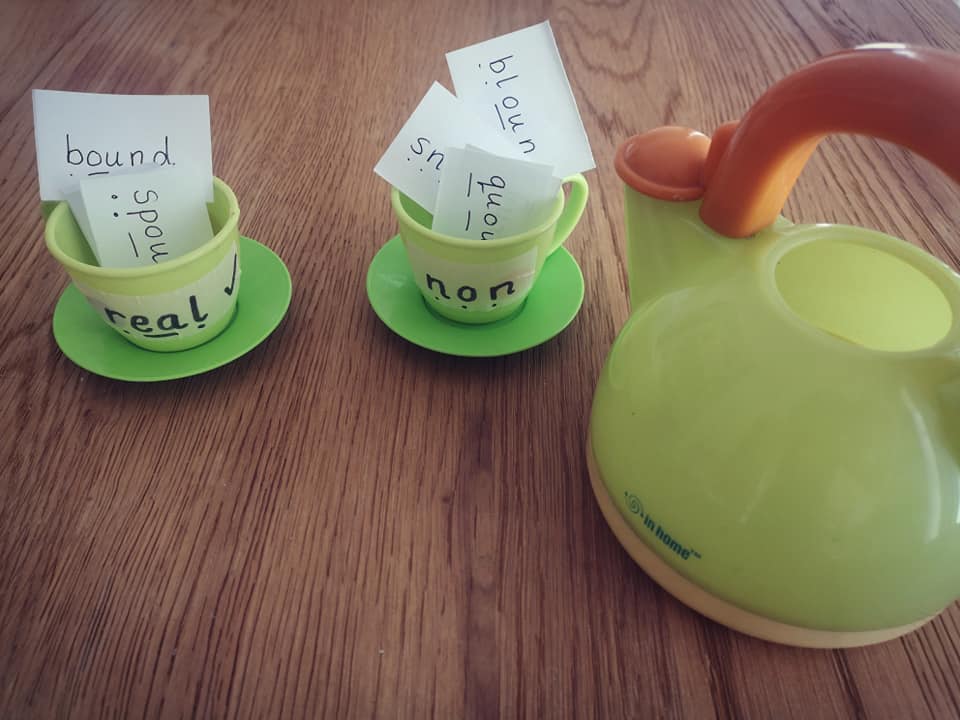

At this time of year you might be getting lots of parcel deliveries. Don’t throw the boxes in the recycling just yet. The packaging and logo of that well known brand #amazon is a perfect way to help demonstrate split digraphs. Cut out the arrow/smile and it makes a fantastic split digraph sound button!
After cutting the arrows/smiles you can use the rest of the box to make other grapheme cards. I stuck letter cards to the ends of each arrow to make the split digraphs. Your child can now explore building and reading split digraph words.Split digraphs are taught within Phase 5a and are just what they say on the tin. A digraph has been split but still makes the same single sound. For example in the word ‘bike’ the digraph ‘ie’ (two letters that make one sound) has been split up and the consonant ‘k’ has been placed in the middle. You may know it as the ‘magic e’. I explain to children that the ‘e’ at the end is making the vowel in the middle say its name rather than its sound. The ‘e’ remains shy or silent and we don’t sound it out in split digraph words.
Children need to practise identifying split digraph words (a short word with an ‘e’ at the end) so they don’t sound out all the letters. The sound button for a split digraph is drawn as an arch (either above or under the word) linking the ‘e’ with the vowel in the middle.
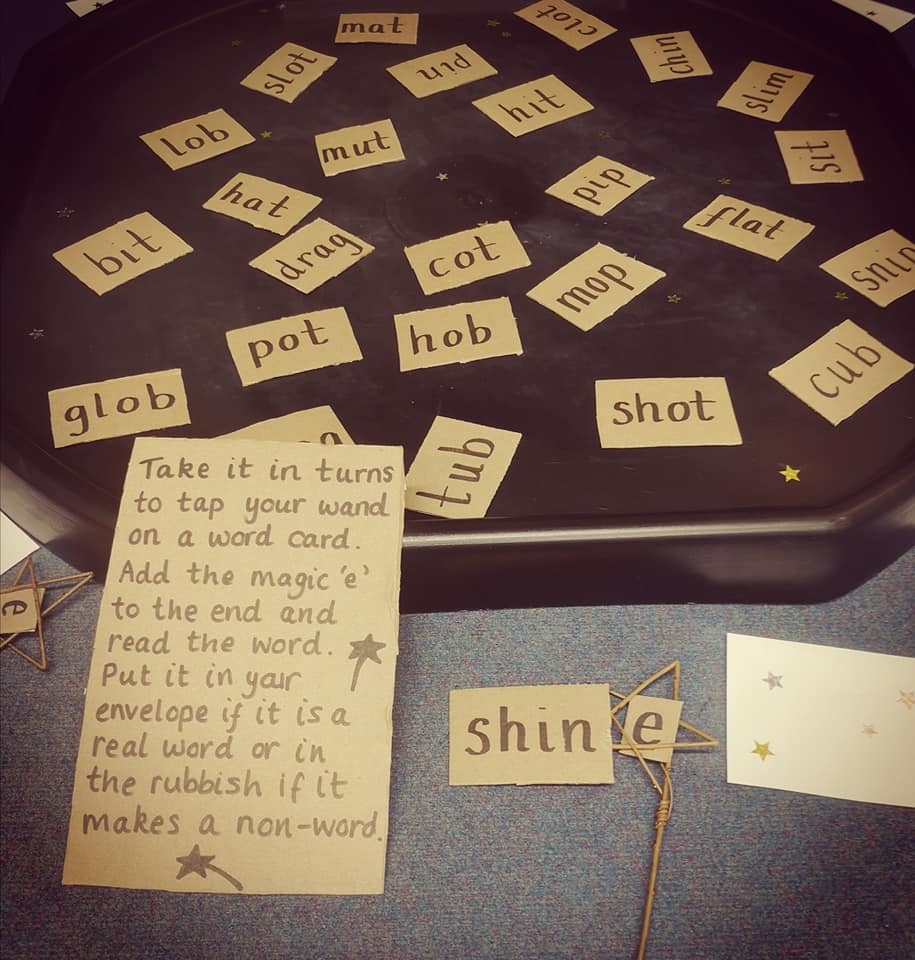
I just set up this game to help prompt children to read split digraph words. The ‘e’ at the end of a split digraph word is often referred to as ‘bossy’, ‘silent’ or ‘magic’ as it makes the other vowel in the split digraph says its name rather than its sound.
A family friend of one of the Year 1 teachers made these incredible wicker wands and I thought they would make perfect magic ‘e’ wands. I just glued some small ‘e’ letter cards to the centre of them. You could use toy wands or stick a cardboard star at the end of a pencil. I then wrote some words onto some card. Some of the words will need to make a real split digraph word when an ‘e’ is added to the end (pin to pine, rob to robe, hat to hate etc). Each player will also need somewhere to collect their cards. I just used some envelopes and stuck in a few star stickers. You could play this game individually or as a group. Each player takes it in turns to tap their wand on a word card. They put the ‘e’ wand to the end of the word and read it as a split digraph word. If it makes a real word they get to keep the card and put it in their envelope. If it creates a non-word they have to put it in the ‘rubbish’ pile. Continue to take it in turns to tap a card and read the words. The winner of the game is the one that has collected the most amount of real split digraph words.
Great as the children will need to pay attention and attempt to read the words on the tray as the other players are taking their turns so they then choose a real word when it is their turn.

Stomp it Out
You will need some word cards with the root word and the s/es, ing, er, ed suffix added to them (plans, planned, planning, planner) but not apply the spelling rules to the word i.e write hopeing as you haven’t followed the spelling rule to take off the ‘e’ before adding the suffix ‘ing’. See the photos and hopefully that will make it clearer.
Scatter the word cards around the room and show your child the suffix and root word grid they need to complete. Your child finds the words and sorts them according to root word and suffix. Once the grid is complete they identify the mistakes. They then use a shoe to ‘stomp out’ the words that are incorrectly spelt or not the correct past tense i.e runned instead of ran. They can then write the word with the correct spelling and replace the cards.
You could then play a game of charades using the words i.e your child picks a card, reads it and then acts it out for you to guess.

This activity is specifically designed for children who are working in Phase 5 and learning the alternative graphemes for the same phoneme (different ways to spell the same sound). Year 1 children will learn these alternatives throughout the year.
I divided a paper plate into 8 sections and wrote the graphemes for some of the Phase 3 phonemes within each section. I then wrote the alternative ways to spell that phoneme onto a peg, put a tick on the other side, and placed them all in a bag. The paper plate and pegs will need to be altered depending on what alternatives your child has covered. Your child’s job is to pick a peg and peg it on to the paper plate next to the alternative graphemes. You could just start with one alternate in the bag and build up the pegs over time.
Once they have sorted all the pegs they can then use them to indicate their best bet decisions. I wrote a word on a piece of paper with three ways to spell it, only one of them correct. Your child uses their phonic knowledge (for example ‘ay’ is found at the end of the word not ‘ai) and chooses the correct peg from the wheel. They peg it next to the correctly spelt word showing the tick.
A great activity to exercise fine motor muscles too 👍🏻

I thought this activity was particularly apt at the moment. Split digraphs are something that children learn in Phase 5 (normally in Year 1). You might know them as the ‘magic e’. It’s when a digraph for example ‘ie’ has been split up and had a consonant placed in the middle. It still makes an ‘ie’ sound despite having this letter in the middle. I like to think of it as the letter ‘e’ at the end is making the vowel say it’s name rather than its sound.
There are 5 split digraphs taught:
i_e like in slide
o_e like in joke
a_e like in cake
u_e like in tube
e_e like in these
When you put sound buttons on a word with a split digraph you connect the two letters with an arched line going over the consonant in the middle. Have a look at the photos and hopefully they will make it clearer.
The activity is to read the words and add the split digraph sound buttons but make it into a rainbow instead of the usual arched line.
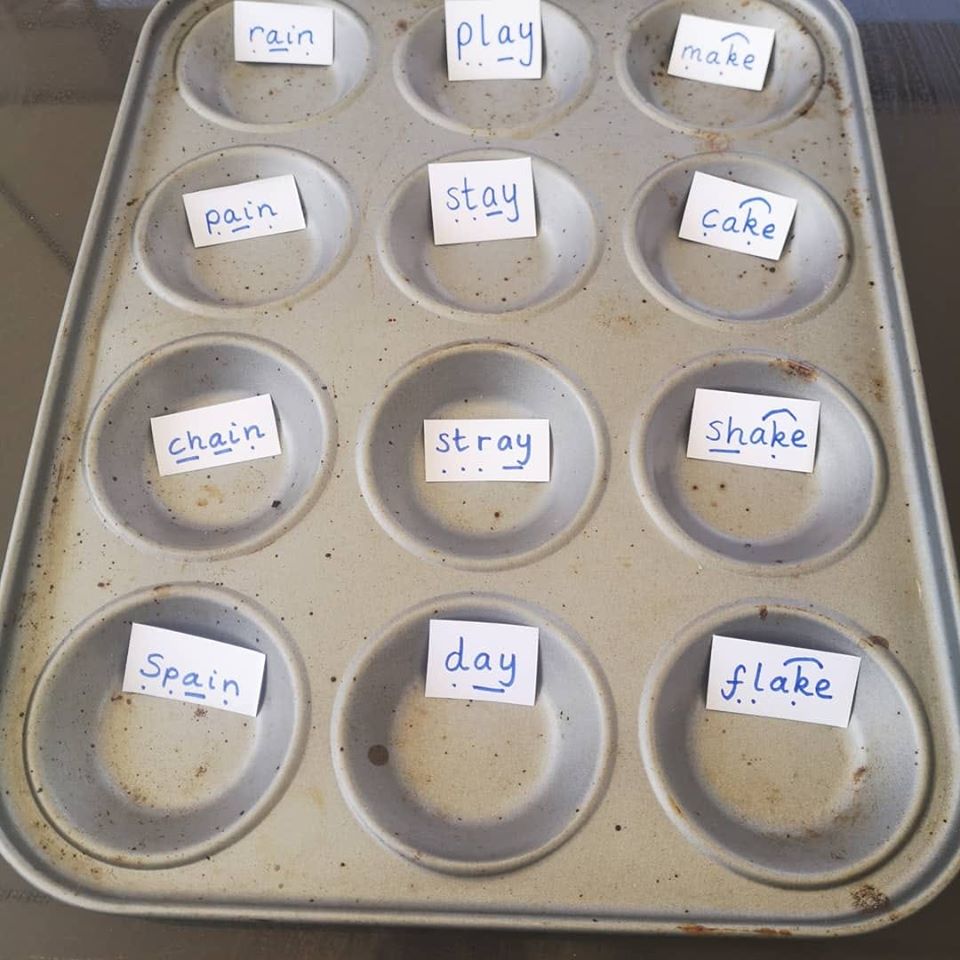
Cake Tin Phonics
Sort the words into the cake tin. A great way to support the recognition of word families and rhyme. Also a super way for children working in Phase 5 to recognise the different ways that we can write the same sound (different graphemes for the same phoneme). In this picture I used three different ways (ai like in pain, ay like in day and split digraph a_e like in cake). Once your child is working in Phase 5 they will learn lots of different ways to write the same sound among them it will include:
oa, ow, oe, o_e
igh, ie, i_e
ee, ea, e_e
or, aw
oi, oy
Once you’ve sorted the word cards, throw a coin and read the word where the coin lands.

A super simple, quick and easy activity to set up.
It is aimed at children who are learning to recognise, segment and blend split digraph words. You might find that your child can easily read split digraph words on cards that have the sound buttons on but when it comes to reading them in a book they ‘sound out’ all the graphemes including the ‘e’ at the end. The word ‘like’ becomes ‘l-i-k-e’ instead of ‘l-ie-k’. In the Year 1 Phonics Screening Check children will need to be able to identify split digraph words and decode them correctly
Give your child a selection of magazines, leaflets, books that you don’t mind being written in, menus and any junk mail that you might have and a set of highlighters. They go through the pages, spot and highlight all the split digraph words. This way you are providing them with the opportunity to spot the words without sound buttons on. Once they’ve finished you can go back through the words together and discuss any mistakes they might have made, for example highlighting tricky words such as ‘some’ and ‘one’ that have the ‘e’ at the end but are not split digraph.
Lots of marking policies in Schools may include using a selection of different coloured highlighters so your child might enjoy having the chance to use them and play ‘teacher’.
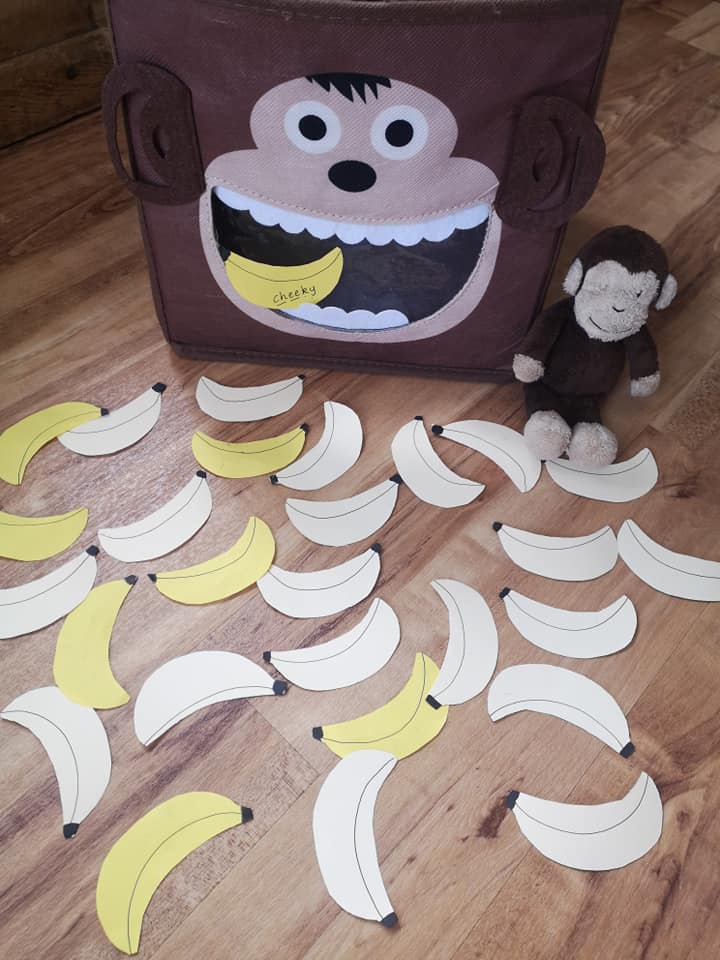
I’ve been eyeing up my son’s book box for a while now thinking how to incorporate it into an activity. Well here it is…
This activity is perfect for children working in Phase 5 and learning the alternate graphemes for the same phoneme. In this game I focused on the alternate ways to write the ‘ee’ phoneme (sound).
ee like in see
ea like in tea
Split digraph e_e
ey like in key
y like in happy
ie like in field
All the banana word cards start upside down. Pick up a banana and read the word. The monkey only eats the words that end in a ‘y’ because he’s a ‘cheeky monkey’. If playing with a partner the winner is the one that finds the most bananas to feed the monkey. Older children could write a sentence for all the words the monkey has eaten.
For younger children working at the beginning of Phase 5 you could concentrate on just three graphemes (ee, ea, e_e) and the monkey only eats words that are split digraph. Phase 3 children could have words that contain Phase 3 graphemes and the monkey only eats ‘ee’ words.
As an alternate to the box you could use a soft toy monkey, a monkey hat or your child could draw or make a monkey for the game.
A fantastic activity for all the budding illustrators.
Make a book by folding some A4 paper in half and stapling down the middle. This is going to be a lift the flap style book so on each page create a small door to open. I just glued down the side of a smaller piece of white paper. Under every door write a word/caption/sentence that indicates who is behind the door. Your child reads the writing to find out what they need to draw behind the door. They can then design and draw a front door too.
I focused this book on the different graphemes for the phoneme ‘n’ as the title of the activity is called ‘knock knock’ so I included words in the sentences that had ‘n’, ‘kn’ and ‘gn’ that children will learn in Phase 5.
Easily adapted for phase by just writing single words or captions and include graphemes that you have been focusing on. As an example:
Phase 2- a big dog, a cat in a hat, a sad man
Phase 3 – a goat with a coat, a big red car on a road, a man with a torch at night
Phase 4 – a green dragon, a black sheep, a little clown
Phase 5 – A white bird, a girl with a blue shawl, a boy with a yellow toy
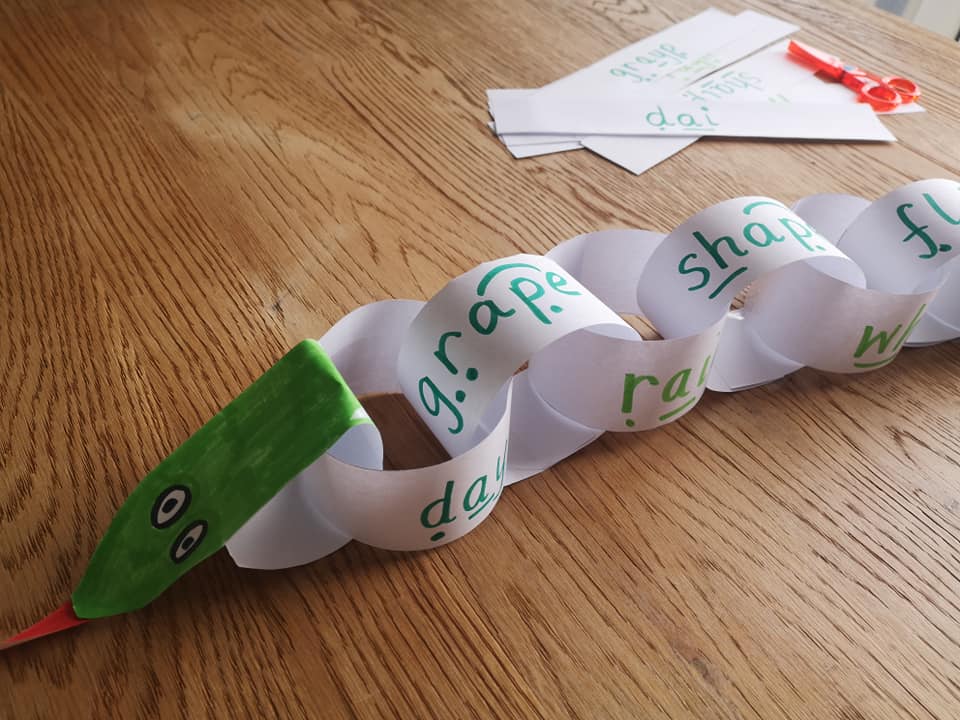
A great activity for children working in Phase 5 where they are learning that different graphemes can make the same phoneme (sound). During this phase children make ‘best bet’ decisions on how to spell words, for example if they hear an ‘ai’ at the end of the word their best bet is that it will be ‘ay’. The same with ‘ie’ instead of ‘igh’. Some words though they just have to be exposed to the different options and make the right choice on what looks right, for example ‘ou’ and ‘ow’ can both be found in the middle so it could be ‘shout’ or ‘showt’. Here they could think about word families and rhyme to aid their decision.
To make a spelling snake cut a A4 sheet (landscape ways) in half and fold each half in two. You then give your child two options to spell a word, one being the correct way and one being the wrong way. They will have to use their phonic knowledge about best bet decisions to cut the one with the correct spelling out. They then use this to create their paper chain snake.
For the snake in the picture I concentrated on three different ways to write the phoneme ‘ai’ but you can adapt it to the graphemes/phonemes you are working on. Instead of wasting the left over paper turn the strips over and your child could write on a correctly spelt word and add it to the paper chain.

A really easy game to set up if you have a set of the plastic coloured plates from IKEA as they make the perfect planet. A great game to encourage your child to recognise specific graphemes in words and practise their decoding skills but it can easily be adapted to suit any phase depending on what you write on the rockets and planets.I used four of the coloured plates and put them on a black tray. I added a little more detail with chalk and a few stickers. I cut small bits of cardboard and wrote a selection of decodable words in rocket outlines. I chose to focus on the r controlled vowel digraphs learnt in Phase 5 ‘ir’ and ‘er’ as alternatives to the ‘ur’ grapheme learnt in Phase 3. Just adapt this for whatever phase your child is working in. You could just have initial sounds on the planets and rockets and your child throws the rocket into the matching letter planet, you could focus on a selection of words with Phase 3 graphemes that your child is finding difficult to recall or you could have tricky words.Your child selects a rocket. Reads the word and then attempts to throw the rocket to make it land on the corresponding planet, so the word ‘bird’ needs to land on the ‘ir’ planet. If the rocket lands on the planet they can collect an alien. How many aliens can they collect altogether? I used some aliens from aToy Story game but you could just have pictures of aliens instead.For children working in Phase 6 you could have some suffixes on the planets like ‘ing’, ‘ed’ and ‘er’ and root words on the rockets. They throw the word onto a planet and then have to write the word with the suffix and correct spelling rule applied before getting an alien, for example throwing a rocket with the word ‘time’ onto the ‘er’ planet and then writing ‘timer’. A fun and practical game that doesn’t take too much to set up and can easily be repeated as your child moves up the phases just with a different focus.
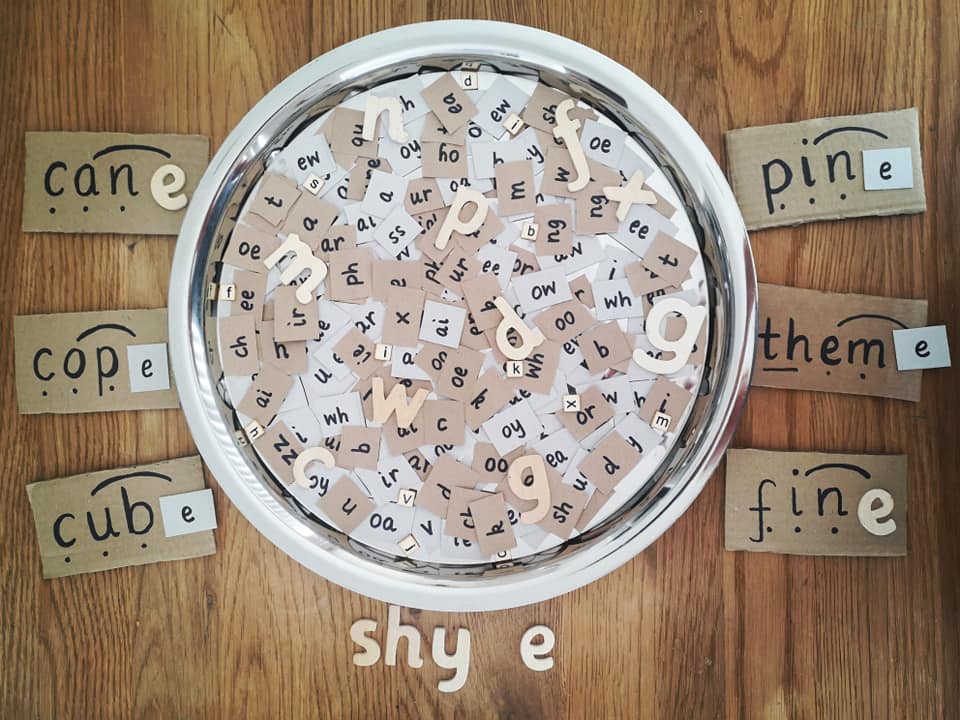
Shy ‘e’ likes hiding amongst all the other graphemes. Can you find one and place it at the end of a word card and see how it has the power to change the word? A great activity to support children’s understanding of split digraphs. You might know it as the ‘magic e’ or ‘bossy e’. Children will learn that the ‘e’ at the end of a digraph such as ‘ie’ is making the initial vowel say its name rather than its sound and the ‘e’ stays quiet. That remains the case when the digraph has been split and a consonant has gone in the middle like in the word ‘pine’. The ‘n’ has gone in the middle of the digraph ‘ie’ but the ‘ie’ still makes the same sound. The ‘e’ remains silent or shy and tells the vowel in the middle to say its name. The word ‘pin’ becomes ‘pine’. The ‘i’ now says its name not its sound. All you need to do for this activity is cut up lots of old cardboard and paper and write graphemes from Phase 2, 3 and 5 on the pieces. Then hide a few ‘e’ cards within the pile. Once your child has completed all the split digraph words they could continue to use the tray by finding a Phase 3 grapheme and its Phase 5 alternative, like ‘or’ and ‘aw’, or they could build words.

I’ve seen these type of boards used for children to indicate the correct initial sounds and I thought they would also be brilliant to indicate a best bet decision. Slightly older children will still really benefit from the fine motor practise too. In general there is only a difference of a year group between learning initial sounds in Reception and then learning the alternative graphemes for the same phoneme in Year 1. This is exactly why I love phonics it’s amazing the progress children make in a relatively short amount of time. Best bet decisions are often used within Phase 5 when children are learning the alternatives. Children will need to use their phonic knowledge to decide which grapheme to use when spelling a word, for example they will learn that if they hear an /ae/ sound at the end of a word the best grapheme to use is ‘ay’ as in say, day and play. For this activity I used some old cardboard and then drew a picture on the top half and wrote three options on how to spell the word on the bottom half. Your child makes a best bet decision and then clips a peg onto the correct spelling.

A great way to reuse an egg box to help children in Phase 5 read and sort words that contain alternative graphemes for the same phoneme, for example ‘ai’, ‘ay,’ ‘a-e’, ‘a’ and ‘eigh’ all make the same sound /ai/.
It works well for those phonemes that have got a few alternative graphemes like ‘ai’, ‘ee’, ‘igh’ ‘oa’ and ‘or’. I took the label off the lid and wrote the Phase 3 grapheme on the top. Inside I made little flags for each compartment of the box and wrote the Phase 5 alternatives on them. You could just use a sticker or post-it note instead. I then wrote words onto small bits of card that contained all the alternatives and placed them in the lid.
Your child now simply reads the word and places it into the correct compartment according to the alternative grapheme it contains. Close the lid and keep it all together for next time. A nice resource to build up especially within a classroom. You could have an egg box for every phoneme containing all the alternative graphemes.

A super easy game to set up and flipping a coin or counter means it can be played pretty independently (no need for someone to be the bingo caller). A good way to support your child in identifying graphemes within words and can be easily adapted to suit Phase 2-6.
I put a couple of stickers on each side of a Connect 4 counter. You could use an actual coin, milk bottle top or cut a disc of card instead. On the stickers I wrote a grapheme. Here I demonstrated with ‘oi’ as in ‘coin’ and its alternative grapheme for the same phoneme (sound) learnt in Phase 5a. I used an old bit of card to create a Bingo board where I wrote words that contained either ‘oi’ or ‘oy’.
Your child simply flips the coin then finds and reads a word that contains that grapheme. They then cross it off their board. For example they flip the coin and it lands on ‘oy’ so they read and cross off the word ‘joy’. They continue to flip until all words have been crossed off the board.
I played with my son who is beginning to read simple CVC word. I had the initial sounds ‘s’ and ‘t’ on the coin and he had to find and attempt to read a word that started with that sound. I put sound buttons under the words to help him segment and blend the sounds. He started to use the dabber on each letter within the word too which aided segmenting and blending.
.
Images © Phonics Family 2020






